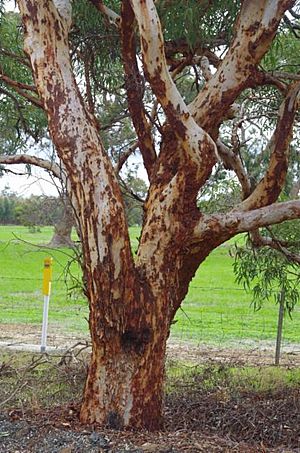Salmon white gum facts for kids
Quick facts for kids Salmon white gum |
|
|---|---|
 |
|
| Eucalyptus lane-poolei growing near Keysbrook | |
| Scientific classification | |
| Genus: |
Eucalyptus
|
| Species: |
lane-poolei
|
The Salmon White Gum (Eucalyptus lane-poolei) is a special type of tree or shrub that grows only in Western Australia. It's called "salmon white gum" because of its smooth, often scaly bark that can look whitish-grey or even orange-brown, like salmon. This plant has long, thin leaves, flower buds that grow in groups of seven, and pretty creamy white flowers. After the flowers, it grows round, woody fruits.
Contents
What Does It Look Like?
The Salmon White Gum can be a tree or a smaller, bushy plant called a mallee. It usually grows to be about 3 to 12 meters (10 to 40 feet) tall. It has a special woody swelling at its base called a lignotuber. This helps the plant regrow after a fire.
Its bark is smooth and can be whitish-grey or orange-brown. It often looks a bit scaly because old pieces of bark peel off. Young plants have dull, light green leaves that are shaped like an egg. They are about 3 to 9 centimeters (1 to 3.5 inches) long.
The adult leaves are long and narrow, sometimes a bit curved. They are about 6.5 to 10 centimeters (2.5 to 4 inches) long.
Flowers and Fruit
The flower buds of the Salmon White Gum grow in groups of seven. They are found where the leaves meet the stem. Each group of buds sits on a stalk called a peduncle. The individual buds also have small stalks called pedicels.
The mature buds are round or oval. They have a rounded cap, called an operculum, which falls off when the flower opens. The flowers are creamy white and bloom at different times of the year, usually between January and April or June and September.
After flowering, the plant produces woody, round fruits. These fruits are like capsules and are about 7 to 14 millimeters (0.3 to 0.5 inches) long. When the cap falls off, it leaves a clear scar.
The main branches of the tree often twist and spread out. The large lignotuber helps the tree grow back after bushfires. Sometimes, new branches grow from the trunk without a fire. These new branches can intertwine with older ones, making the tree look tangled and unique.
Where Does It Grow?
The Salmon White Gum is found along the west coast of Western Australia. It grows in areas like the Wheatbelt, Peel, and South West regions. You can find it from Coorow in the north down to Busselton in the south.
It prefers sandy soils or sandy-loam soils that have laterite or granite gravel. It is naturally found in most of these areas. However, it has also started growing in other places where it wasn't originally found. A special group of these trees grows on the western side of the Darling Range.
Other plants that often grow near the Salmon White Gum include the Honeypot Dryandra and Baumea preissii. This tree likes wetter spots in the Perth area, especially on the Swan Coastal Plain. It can grow well in places where other large eucalyptus trees, like Marri and Wandoo, might struggle.
Who Named It?
The Salmon White Gum was first officially described in 1919 by a botanist named Joseph Maiden. He studied a sample collected in the same year by Charles Edward Lane-Poole. Charles was a forester from Western Australia.
The scientific name lane-poolei was chosen to honor Charles Edward Lane-Poole. He collected this plant and did a lot to help people study eucalyptus trees in Western Australia.
Is It Protected?
The Western Australian Government's Department of Parks and Wildlife says that the Salmon White Gum is "not threatened." This means it is not currently at risk of disappearing.

